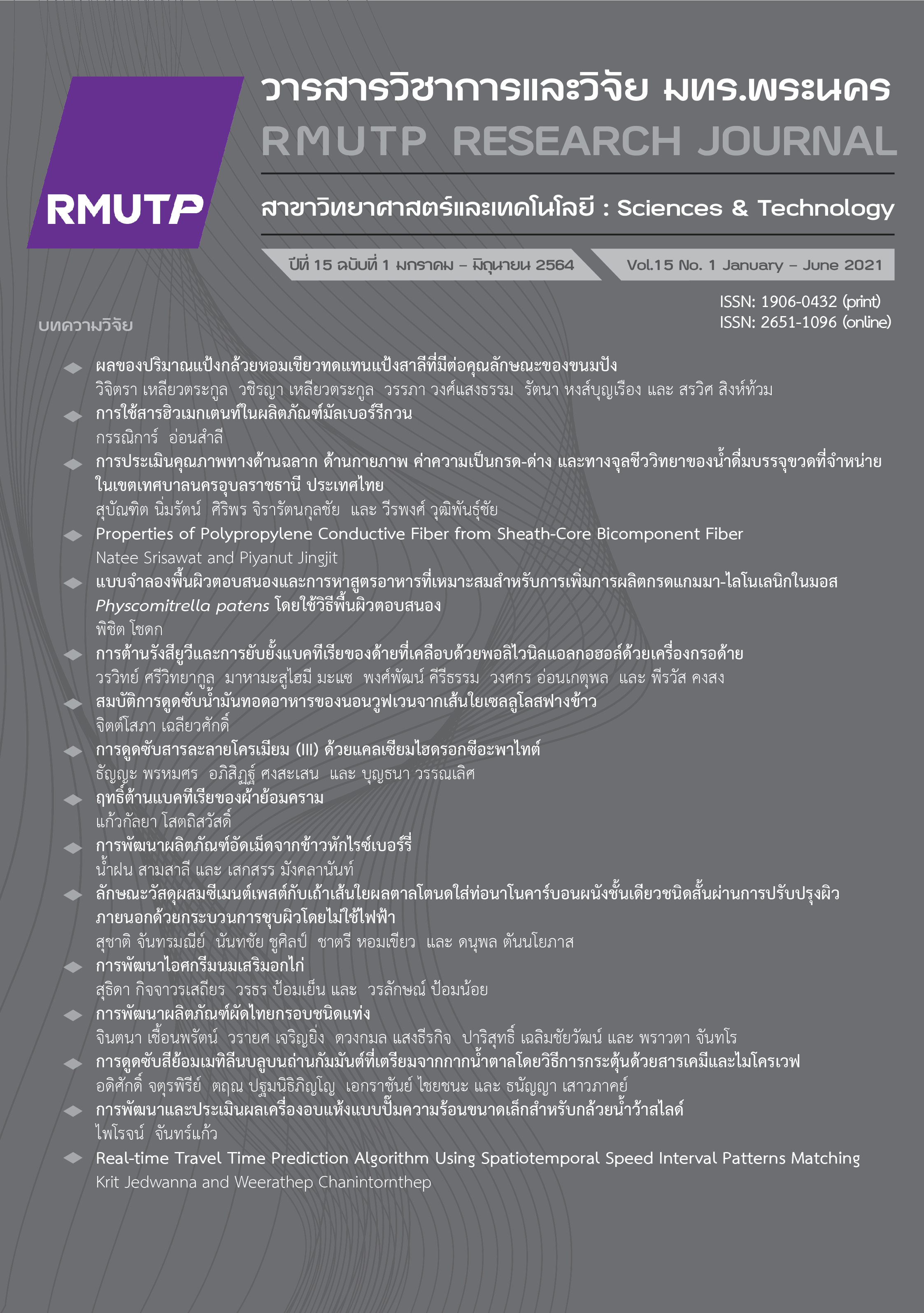สมบัติการดูดซับน้ำมันทอดอาหารของนอนวูฟเวนจากเส้นใยเซลลูโลสฟางข้าว
Main Article Content
บทคัดย่อ
งานวิจัยนี้มีวัตถุประสงค์เพื่อศึกษาการสกัดเส้นใยเซลลูโลสฟางข้าวด้วยสารละลายโซเดียมไฮดรอกไซด์ในภาวะที่ต่างกัน (ความเข้มข้นร้อยละ 5 10 และ 15 ที่อุณหภูมิห้อง 60 และ 90 องศาเซลเซียส เป็นเวลา 0.5 1 2 และ 3 ชั่วโมง) และศึกษาการเตรียมนอนวูฟเวนฟางข้าวด้วยวิธีการผลิตแผ่นเส้นใยแบบเปียก แล้วทดสอบความสามารถในการดูดน้ำมันในแนวดิ่ง การดูดซึมน้ำมัน การซึมผ่านของอากาศ และลักษณะทางกายภาพของนอนวูฟเวนที่เตรียมได้ พบว่า ภาวะที่เหมาะสมในการสกัดเส้นใยเซลลูโลสฟางข้าว คือ สกัดด้วยสารละลายโซเดียมไฮดรอกไซด์ความเข้มข้นร้อยละ 5 ที่อุณหภูมิ 90 องศาเซลเซียส เป็นเวลา 2 ชั่วโมง โดยจะให้ปริมาณเส้นใยเซลลูโลสฟางข้าวร้อยละ 22 ความยาวเส้นใย 1.96 เซนติเมตร จากการทดสอบความสามารถในการดูดน้ำมัน และการดูดซึมน้ำมันของนอนวูฟเวนฟางข้าว พบว่า ความสามารถในการดูดน้ำมัน และการดูดซึมน้ำมันของนอนวูฟเวนฟางข้าวจะเพิ่มขึ้น เมื่อน้ำหนักเส้นใยต่อพื้นที่เพิ่มขึ้น เนื่องจากน้ำมันจะซึมผ่านเข้าไปในนอนวูฟเวนโดยอาศัยช่องว่างระหว่างเส้นใยของนอนวูฟเวนด้วยปรากฏการณ์การซึมตามรูเล็ก และนอนวูฟเวนฟางข้าวสามารถดูดน้ำมันและดูดซึมน้ำมันปาล์มก่อนทอดอาหารได้ดีกว่าน้ำมันปาล์มหลังทอดอาหาร เนื่องจากน้ำมันปาล์มก่อนทอดอาหารมีความหนืดน้อยกว่าน้ำมันปาล์มหลังทอดอาหาร โดยความหนืดเพิ่มขึ้นจากอนุพันธ์ของลิพิด และสารอื่น ๆ ที่ละลายหรือแขวนลอยในน้ำมันมากขึ้นหลังทอดอาหาร ทำให้การเคลื่อนที่ซึมผ่านของน้ำมันปาล์มหลังทอดอาหารทำได้ยากกว่าน้ำมันปาล์มก่อนทอดอาหาร จากผลการทดลองชี้ให้เห็นว่านอนวูฟเวนฟางข้าวมีสมบัติดูดซึมน้ำมันได้
Article Details
เอกสารอ้างอิง
Center of Agricultural Information, Office of Agricultural Economics, “Thailand foreign agricultural trade statistics 2019,” Agricultural Statistics, vol. 403, pp. 27-30, 2019.
P. Wangbon, “The story of rice straw,” Green Globe, vol. 10, pp. 4, Apr.-Jun. 2008.
P. Binod, R. Sindhu, R .R. Singhania, S. V., L. Devi, S. Nagalakshmi, N. Kurien, R. K. Sukumaran and A. Pandey, “Bioethanol production from rice straw: An overview,” Bioresource Technology, vol. 101, no. 3, pp. 4767–4774, Jul. 2010.
P. Bajpai, Structure and Properties of Cellulose and Nanocellulose, in Pulp and Paper Industry Nanotechnology in Forest Industry, Elsevier, 2016, pp. 27-40.
V. K. Thakur and M. K. Thakur, “Processing and characterization of natural cellulose fibers/thermoset polymer composites,” Carbohydrate Polymers, vol. 109, pp. 102–117, Aug. 2014.
R. Pawongrat, “Pretreatment processes for enhancing the efficiency of ethanol production from lignocellulosic agricultural wastes,” Veridian E-Journal, Science and Technology Silpakorn University, vol. 1, no. 1, pp. 143-157, Jan.-Jun. 2015.
N. Johar and I. Ahmad, “Morphological, thermal, and mechanical properties of starch biocomposite films reinforced by cellulose nanocrystals from rice husk,” BioResources, vol. 7, no. 4, pp. 5469-5477, Sep. 2012.
M. Boonterm, S. Sunyadeth, S. Dedpakdee, P. Athichalinthorn, S. Patcharaphun, R. Mungkung and R Techapiesancharoenkij, “Characterization and comparison of cellulose fiber extraction from rice straw by chemical treatment and thermal steam explosion,” Journal of Cleaner Production, vol. 134, pp. 592-599, Oct. 2016.
V. G. Yachmenev, D. V. Parikh and T. A. Calamari, “Thermal Insulation Properties of Biodegradable, Cellulosic-Based Nonwoven Composites for Automotive Application,” Journal of Industrial Textiles, vol. 31, no. 4, pp. 283-296, Apr. 2002.
X.-F. Sun, R. Sun and J.-X. Sun, “Acetylation of Rice Straw with or without Catalysts and Its Characterization as a Natural Sorbent in Oil Spill Cleanup,” Journal of agricultural and food chemistry, vol. 50, pp. 6428–33, Nov. 2002
D. Li, F. Z. Zhu, J. Y. Li, P. Na and N. Wang, “Preparation and Characterization of Cellulose Fibers from Corn Straw as Natural Oil Sorbents,” Industrial & Engineering Chemistry Research, vol. 52, pp. 516–524, Dec. 2012.
D. Hu, X. Li, L. Li and C. Yang, “Designing high-caliber nonwoven filter mats for coalescence filtration of oil/water emulsions,” Separation and Purification Technology, vol. 149, pp. 65–73, Jul. 2015.
Y. He, Y. Pang, Y. Liu, X. Li and K. Wang, “Physicochemical characterization of rice straw pretreated with sodium hydroxide in the solid state for enhancing biogas production,” Energy & Fuels - ENERG FUEL, vol. 22, pp. 2775–2781, Jul. 2008.
H. Yang, R. Yan, H. Chen, D. H. Lee and C. Zheng, “Characteristics of hemicellulose, cellulose and lignin pyrolysis,” Fuel, vol. 86, pp. 1781–1788, Aug. 2007.
L.-P. Xu, B. Dai, J. Fan, Y. Wen, X. Zhang and S. Wang, “Capillary-driven Spontaneous oil/water Separation by Superwettable Twine,” Nanoscale, vol. 7, no. 31, pp. 13164-13167, Jul. 2015.
K. Bordin, M. T. Kunitake, K. K. Aracava and C. S. F. Trindade, “Changes in food caused by deep fat frying – A review,” Archivos latinoamericanos de nutrición, vol. 63, no. 1, pp. 5-13, Mar. 2013.
K. C. M. de Lima, H. D. de F. Barros, T. S. Passos, and B. L. L. Maciel, “The effect of using different oils and paper towel in vegetable oil absorption of fried recipes,” Journal of Culinary Science & Technology, vol. 17, no. 4, pp. 373–384, Jul. 2019


